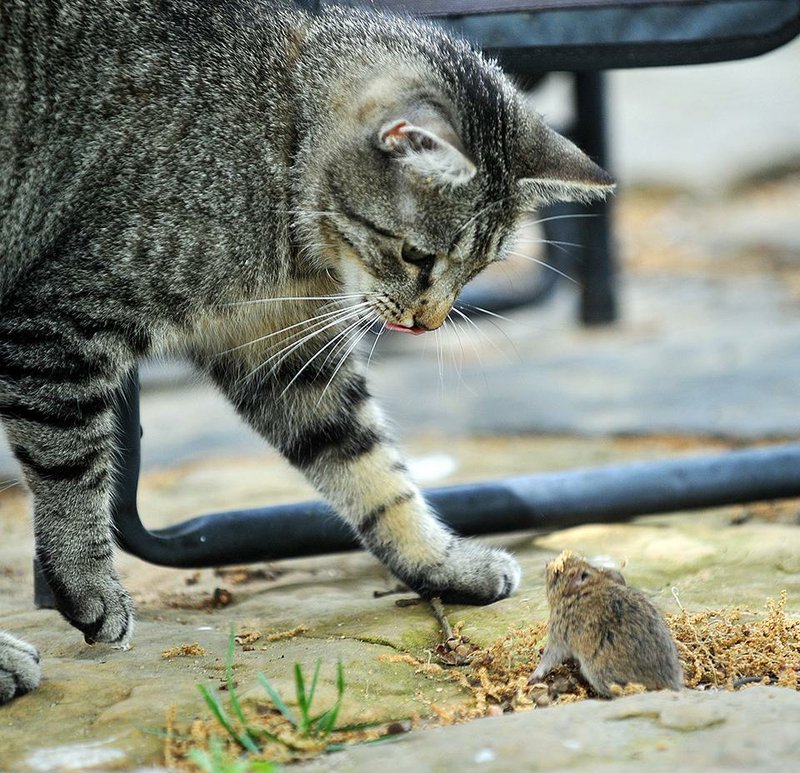Jennifer L. McDonald is an ecologist by profession and a cat person by avocation. Years ago, Tiggy, her ginger-and-white shorthair, would bring home freshly killed mice and shrews for her consideration.
And consider them she did.
McDonald, now an associate research fellow at the Center for Ecology and Conservation at the University of Exeter in England, was curious about the impact of pet cats like Tiggy on wildlife. Fewer mice might be nice. But cats, natural hunters, pounce on birds and rabbits, too.
"You can't pick and choose a cat's prey," McDonald said. If owners realized how much prey their pets killed, she wondered, would they be willing to contain their cats to protect wildlife?
She and her associates studied the question. The answer, published recently in the journal Ecology and Evolution, was unequivocal and emphatic.
No.
In recent years, debates about the predatory effect of cats on wildlife, particularly endangered songbirds, have only intensified. But most public opinion surveys have focused on the management of feral cats, which make up the majority of domestic feline marauders, particularly in the United States.
For the study, "Reconciling Actual and Perceived Rates of Predation by Domestic Cats," McDonald and colleagues surveyed owners in two British villages about cats they allowed to roam outdoors. Owners were asked to predict the amount of prey taken by their cats and then document the actual killings. Owners in one village were then asked whether they believed pet cats had an ecological impact.
Researchers also asked owners about their willingness to keep cats indoors during prime hunting time, from dusk to dawn. The idea was flatly rejected, with some owners providing unsolicited commentary: "My cat chooses for herself whether to stay in or go out," one wrote.
Pointing to "a dissociation between actual and perceived predatory behavior," the researchers concluded that "the cat owners in this study reject the proposition that cats are a threat to wildlife."
Sara J. Ash, a professor of ecology and conservation biology at the University of the Cumberlands in Williamsburg, Ky., said that the results highlighted the deep division between cat owners, who see their individual animals as doing what comes naturally, and ecologists, who view cats as a predatory, non-native species.
"These owners think, 'My cat only kills two mice a day,'" Ash said. "But they don't think about the high density of well-fed cats throughout their neighborhood."
The study's cat owners were generally able to predict whether their pets would bring home prey, but they fared poorly at estimating how much. Among 43 cats tabulated in the Cornwall village of Mawnan Smith, the average monthly catch ranged from none to 10.
Over four months, the cats delivered a total of 325 animals: Nearly 60 percent were rodents, and 27 percent were birds. (According to researchers, 6.2 percent were unidentifiable.)
Although Mawnan Smith and another village in the study, Thornhill, in Scotland, are in rural settings, these owners' reactions corresponded with those of urban cat owners in Britain. In a 2012 study (bit.ly/1fEal0y), urban cat owners said overwhelmingly that they did not believe cats depleted numbers of six common city birds.
Researchers in that study noted that the number of kills any one cat brought home per year seemed to vary widely from year to year and also shrank in response to how many other cats were loose in the area. Over eight years, owners' perceptions of how often their pets killed grew.
WHO KNOWS?
John Bradshaw, a professor of anthrozoology at the University of Bristol in England, noted that the owners in this latest study counted only the prey their cats had brought home, and did not know how many creatures the cats might have left elsewhere -- scenarios vividly illustrated in a 2013 study by National Geographic and the University of Georgia for which researchers attached "kitty cams" to 55 pet cats (video results available at kittycams.uga.edu). Those cats left behind nearly half the prey they had killed.
But Bradshaw, the author of Cat Sense: How the New Feline Science Can Make You a Better Friend to Your Pet (Basic Books, 2014), questioned whether cats were really having an ecological impact.
"No doubt pet cats kill lots of little animals, but are they doing long-term harm in the United States and Britain?" said Bradshaw, who says that the evidence is "flimsy."
Some researchers argue that while cats do have an impact on endangered species, notably on oceanic islands with few indigenous predators, the danger they pose in Europe and North America is hardly as significant as housing development, drought or pollution.
Noting that the biodiversity threat was insufficient to persuade owners to keep their cats indoors, McDonald and her colleagues suggested a different tactic: emphasizing the deadly hazards to pets that wander at will from road traffic, for example, and larger predators. Increasingly, in the United States, that has meant coyotes.
According to a study published by The Journal of Mammalogy in June, cats, and possibly some owners, are getting the memo. For the report "Cats Are Rare Where Coyotes Roam," U.S. wildlife researchers investigated whether cats, which they assumed hunted mainly in residential areas, were also foraging in parks, where biodiversity is richer. Or were cats avoiding those areas because of coyotes?
With nearly 500 volunteers, researchers placed cameras in 32 parks and one urban area in six states. They found that many coyotes, but very few cats, stalked those protected public lands.
That was even true of Rock Creek Park in Washington, which is surrounded by residences and likely thousands of pet cats. Yet in six months, researchers caught coyotes on camera 125 times in the park, but photographed a cat only once.
But cats and coyotes did overlap in what researchers described as "small urban forests" -- smatterings of woodland along greenways in suburban and exurban neighborhoods where coyotes are encroaching.
Celia Storey contributed information to this report.
ActiveStyle on 08/03/2015
